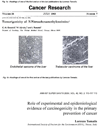Somatic mutations in cancer development
- PMID: 21489208
- PMCID: PMC3073190
- DOI: 10.1186/1476-069X-10-S1-S12
Somatic mutations in cancer development
Erratum in
- Environ Health. 2011;10 Suppl 1:S16
Abstract
The transformation of a normal cell into a cancer cell takes place through a sequence of a small number of discrete genetic events, somatic mutations: thus, cancer can be regarded properly as a genetic disease of somatic cells. The analogy between evolution of organisms and evolution of cell populations is compelling: in both cases what drives change is mutation, but it is Darwinian selection that enables clones that have a growth advantage to expand, thus providing a larger target size for the next mutation to hit. The search for molecular lesions in tumors has taken on a new dimension thanks to two powerful technologies: the micro-arrays for quantitative analysis of global gene expresssion (the transcriptome); and 'deep' sequencing for the global analysis of the entire genome (or at least the exome). The former offers the most complete phenotypic characterization of a tumor we could ever hope for--we could call this the ultimate phenotype; the latter can identify all the somatic mutations in an individual tumor--we could call this the somatic genotype. However, there is definitely the risk that while we are 'drowned by data, we remain thirsty for knowledge'. If we want to heed the teachings of Lorenzo Tomatis, I think the message is clear: we ought to take advantage of the new powerful technologies--not by becoming their slaves, but remaining their masters. Identifying somatic mutations in a tumor is important not because it qualifies for 'oncogenomics', but because through a deeper understanding of the nature of that particular tumor it can help us to optimize therapy or to design new therapeutic approaches.
© 2011 Luzzatto; licensee BioMed Central Ltd.
Figures













References
-
- Vogelstein BaK, K W. The Genetic Basis of Human Cancer. 2nd. New York: McGraw-Hill; 2002.
-
- Offit K. Clinical cancer genetics: risk counseling and management. Vol. 1. New York: Wiley-Liss; 1998.
MeSH terms
LinkOut - more resources
Full Text Sources
Miscellaneous

